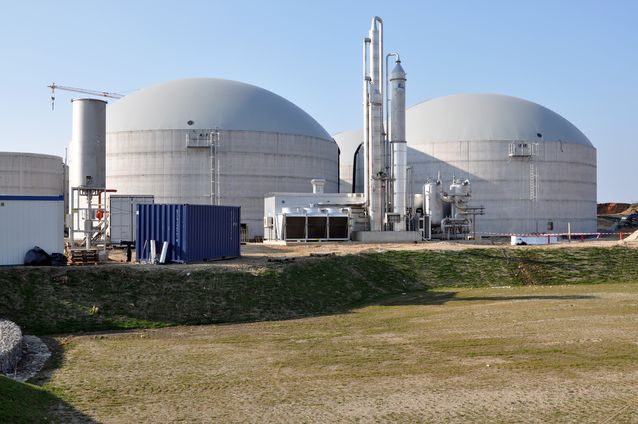Natural gas is a well-known fuel. Biogas can be regarded as “a renewable, but lean natural gas” – but where does it come from, what kind of role it can play in power generation? And what does it mean, when it is being said that “biogas does not have a valve”?
What is biogas?
To put it simply; biogas is a gaseous fuel derived from the decay of organic matter. In other words, once you have organic matter in special environment, bacteria start the process of decomposition (via anaerobic digestion in the absence of oxygen) and as a result, a mixture of methane and carbon dioxide is produced. This mixture is called biogas. Natural gas is mostly methane (usually from 87% up to 97%). Untreated biogas at its best quality has up to 65% methane and while most of the balance of the gas does not take part in combustion, the phrase “renewable, or lean natural gas” for biogas is pretty accurate.
How much biogas is being utilised and how much potential does it have?
Biogas is often neglected in general discussions regarding renewable fuels and this is a real pity. Biogas has enormous potential and the benefits of the gas don’t just stop at power generation. The local production of biogas can in many cases decrease local soil and water pollution and enable recycling of useful fertilisers such as phosphates.
As regards power generation and replacing fossil fuels; in Europe there has been a constant growth in the number of biogas plants over recent years. According to the latest data from European Biogas Association, Europe sustains 17 240 biogas and 367 biomethane plants with total installed electrical capacity of 8 293 MW: in other words, this is slightly more than 8 average size nuclear power plants.
What kind of biogases exist?
There are four different main classes for biogas; landfill gas, agricultural biogas, waste water treatment plant biogas and industrial biogas. They differ not only from how they are being made but also in their composition.
Landfill gas
Landfill gas occurs naturally on landfill sites.
When a lot of organic material is dumped in one place and especially, when the pile is covered and made as gas tight as possible to prevent air leaking into the organic material, biogas will start to form. The bacteria within the site will decompose the organic material and transform it into biogas. On well-managed sites this gas is sucked away through a piping system and flared but quite often this used in power generation.
Landfill gas is a renewable energy source as its nature is recycling. Once the organic waste is dumped in a landfill, depending on the size, material and structure of the site, it potentially can produce gas well beyond 50 years!
Agricultural biogas
On farms the manure of the animals and other organic waste materials from fields can be used for biogas production. The agricultural biogas production has many positive sides, it contributes to creating jobs in rural areas and enhances the circulation of nutrients and thus reduces the need for artificial fertilisation.
Waste water treatment plants
The waste water has organic material that can be used for biogas production. Every modern waste water treatment facility operator with sufficient organic content is at least considering biogas production as it has multiple economic and environmental benefits. In addition to renewable power generation, the biogas plant also makes the waste water treatment process work more efficiently and thus lowering the processing requirements for producing quality final water.
Industrial biogas
Industries such as food & beverage can achieve valuable energy savings by using their process waste for their own energy production. This process benefits the biogas plant owner by generating a revenue stream from exporting power or delivers energy savings by reducing imported power. Furthermore, it recycles waste into energy, avoids waste haulage and disposal costs. All of these benefits provide the operator with operational efficiencies which lower production costs and improve competitiveness.
Biogas has its flaws and concerns, too
When one looks at the multiple benefits of the above mentioned applications and thinks about the total potential for biogas, it seems that the biogas could be a perfect fit from any view point. The fact that biogas is one of the very few renewable fuels capable of 24/7 power generation and is almost uniquely able to deliver adequate heat for industrial processes, you would not think that biogas had any criticism; quite the opposite. Unfortunately, biogas has its negative side too.
The concerns are mainly levelled at agricultural biogas production. The argument is that field acreage previously used for food production is being harnessed for growing organic material for biogas production: plus, within biogas there are some harmful components. These components include the production of sulphur and siloxanes that can destroy any reciprocating engine using the gas and need to be extracted or treated in a costly manner.
Biogas has also one natural element that can be easily forgotten; as the biogas production is a natural, not an artificial process, it can be controlled only relatively slowly. Furthermore, as these processes are typically not pressurised and therefore quite modest in size, economies of scale are difficult to achieve and subsidies are usually required. Thus, it can be said that biogas has “no valve” and the utilisation of the gas should be planned just to match efficiently all the different operational conditions.
Biomethane versus biogas
Biomethane is being sold in some filling stations for cars that can use gaseous fuels. It is also being fed into natural gas grid networks in some locations. But what is biomethane?
When biogas is cleaned and the harmful components and CO2 are removed, what is left is biomethane. In other terms, this is natural gas quality but from renewable biogas.
The sites producing biomethane are relatively expensive and thus they need to be relatively large to make economic sense.
Aurelia’s approach to biogas
We at Aurelia think the world needs different biofuels. Not all power can be generated with just wind & solar. The main design principle of our turbines is that they are flexible to be able to match almost all the possible needs of the efficient, small scale power generator.
Due to the modular structure and its interchangeable single-can combustion chamber, Aurelia’s turbines have the flexibility to use renewable fuels like biogas. As a matter of fact, we are able to incorporate ultra-low heat value combustion systems into our turbines and thus take advantage of fuels that no other technology can economically do. This together with high efficiency at partial load operation and cost-effective combined power and heat possibilities coupled with a small carbon footprint makes our turbine just ideal for all the different biogas applications.




